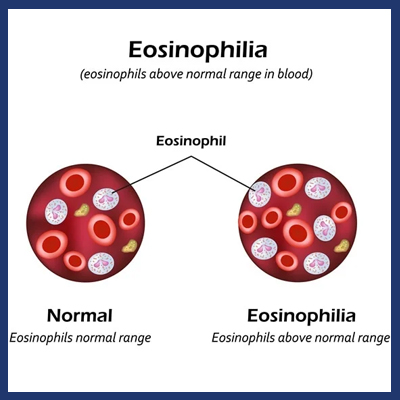Eosinophilia is a higher than normal level of eosinophils. Eosinophils are a type of disease-fighting white blood cell. This condition most often indicates a parasitic infection, an allergic reaction or cancer.
High levels of eosinophils in blood (blood eosinophilia) or in tissues at the site of an infection or inflammation (tissue eosinophilia).
Tissue eosinophilia may be found in samples taken during an exploratory procedure or in samples of certain fluids, such as mucus released from nasal tissues. If you have tissue eosinophilia, the level of eosinophils in your bloodstream is likely normal.
Blood eosinophilia may be detected with a blood test, usually as part of a complete blood count. A count of more than 500 eosinophils per microliter of blood is generally considered eosinophilia in adults. A count of more than 1,500 eosinophils per microliter of blood that lasts for several months is called hypereosinophilia.
SYMPTOMS OF EOSINOPHILIA
If you have eosinophilia, your symptoms will partially be determined by the cause of the elevated eosinophilia count. If your eosinophil count is mildly elevated you may not have any symptoms.1 Common symptoms include:
- Rash
- Itching
- Diarrhea, in the case of parasite infections
- Asthma
- Runny nose, particularly if associated with allergies
CAUSES OF EOSINOPHILIA
There are numerous reasons your eosinophil count may be elevated. Some of the causes are benign and require little treatment. It is not uncommon for the elevated count to be transient and resolve without treatment.
- Parasite infections: Worldwide the most common cause of eosinophilia is a parasite infection.2 Names of these infections include schistosomiasis, trichinosis, strongyloidiasis, and ascariasis. These parasites can be found worldwide including the United States. Travel history is an important part of the work-up for eosinophilia although a lack of recent travel does not rule out parasitic infections.
- Drug reactions: Medications can trigger eosinophilia, sometimes without any obvious signs or symptoms. The most common medications associated with eosinophilia include antibiotics (penicillin, cephalosporins), non-steroidal anti-inflammatory medications (aspirin, ibuprofen), phenytoin (anti-seizure) and allopurinol (used to treat gout). The most severe form is called drug reaction with eosinophilia and systemic symptoms (DRESS).3 Fortunately, most people will not have these reactions when they receive these medications.
- Atopy: Atopy is a particular reaction that occurs in the body. Typically, atopy refers to asthma, seasonal allergies (also called allergic rhinitis), and eczema. It is not uncommon for someone to have more than one of these medical conditions as they are related. These are some of the most common causes of mild to moderate eosinophilia, particularly in children. Similarly, food allergies can also cause elevated eosinophil counts.
- Eosinophilic Esophagitis (EoE): This is a disorder characterized by eosinophils spreading to the esophagus which normally does not contain eosinophils. About 50% of people with EoE will also have elevated eosinophil counts in the blood.4
- Hypereosinophilic Syndromes: Hypereosinophilic syndromes (HES) are a group of disorders characterized by very high eosinophil counts and evidence of organ damage from a large number of eosinophils. Organs commonly targeted are skin, lung, and gastrointestinal tract. HES can be primary (also called neoplastic) secondary (reactive) or idiopathic (cause unknown).5
- Churg-Strauss Syndrome: Churg-Stauss vasculitis, now called eosinophilic granulomatosis with polyangiitis, can cause eosiniophilia.6 People with this condition present with asthma and other lung issues initially, then develop eosinophilia, and eventually vasculitis, inflammation of the blood vessels.
- Cancers: There are several cancers, particularly blood cancers, that are known for increasing the eosinophil count.1 These include a rare type of acute myeloid leukemia (AML) called eosinophilic leukemia. Other causes include several of the myeloproliferative neoplasms (such as essential thrombocythemia, polycythemia vera) B-cell and T-cell lymphoma, as well as adenocarcinomas of the gastrointestinal tract, lung, and cervix.
DIAGNOSIS OF EOSINOPHILIA
Like most blood disorders, eosinophilia is identified on complete blood count (CBC). Eosinophils are one of the white blood cells and are found in the portion of the CBC called the differential. The differential reports how many of each type of white blood cells (neutrophil, lymphocyte, monocyte, eosinophil, and basophil) are present in the blood.
After identification of eosinophilia, your healthcare provider will start working towards identifying the cause, sometimes this requires referral to a hematologist. Eosinophilia can be categorized by the number of eosinophils (absolute eosinophil count).
Mild: 500 - 1500 cells/mL
Moderate: 1500 - 5000 cells/mL
Severe: > 5000 cells/mL
HOMOEOPATHIC TREATMENT FOR EOSINOPHILIA
Homeopathy is one of the most popular holistic systems of medicine. The selection of remedy is based upon the theory of individualization and symptoms similarity by using holistic approach. This is the only way through which a state of complete health can be regained by removing all the sign and symptoms from which the patient is suffering. Some important remedies are given below for Eosinophilia symptoms treatment:
- ALLIUM CEPA
- ANTIMONIUM TARTARICUM
- ARSENICUM ALBUM
- CHAMOMILLA
- DROSERA
- IPECAC
- KALI BICH
- NATRUM SULPH
- PHOSPHORUS ,e.t.c


